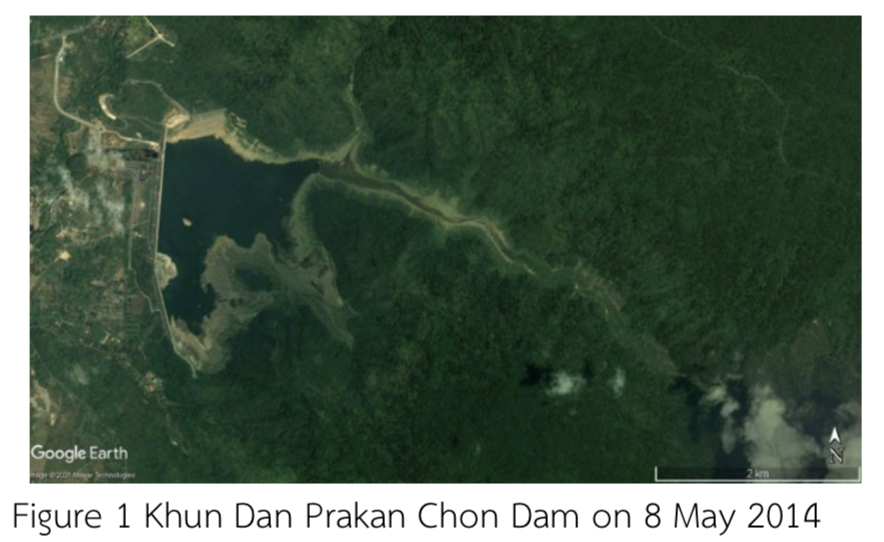PDF Estimating Water Surface Area from Satellite Image by Using Image Processing Technique
Main Article Content
บทคัดย่อ
Estimating Water Surface Area from Satellite Image by Using Image Processing Technique aims to estimate water surface area from selected satellite images by developing deep learning technique algorithms. The algorithm recursively deep-learns from the distribution of colors in satellite images to provide statistical data for the algorithm's decision-making. There are two important steps; 1.Learning to segment the actual color of water surface obtained from satellite images; 2.The classification between surface and non-water surface areas; 3. Learning algoritm for calculating the water surface area from satellite images. This study used water surface area from Google Earth Pro satellite imagery of the Khun Dan Prakanchon Dam, Nakhon Nayok Province, as a studied area.
The calculation of reservoir water surface area in this research was divided into two methods; Google Earth Pro and analysis of algorithm for dispersion of the color data. Therefore, algorithm for dispersion of the color data to find the water surface area can be obtained quickly, high accuracy and precision. Moreover, it can be extended by applying to calculate the water surface area of a medium-sized reservoir or a small reservoir that the reservoir capacity curve is not provided.
Article Details

อนุญาตภายใต้เงื่อนไข Creative Commons Attribution-NonCommercial-NoDerivatives 4.0 International License.
สมาคมวิศวกรรมเกษตรแห่งประเทศไทย
Thai Socities of Agricultural Engineering
เอกสารอ้างอิง
-จุฑาศินี ธัญประณีตกุล, รัชพล สัมพุทธานนท์ และ พรชัย ตระกูลวรานนท์. 2558. การประยุกต์ใช้โปรแกรมกูเกิลเอิร์ทเพื่อการเฝ้าระวังภัยพิบัติ : กรณีตัวอย่างน้ำท่วมในนิคมอุตสาหกรรมลาดกระบัง ปี พ.ศ.2554,วารสารวิทยาศาสตร์และเทคโนโลยี (23): 398 - 417.
-ธนพล พลภักดี, จิระกานต์ ศิริวิชญ์ไมตรี และ วราวุธ วุฒิวณิชย์. 2559. การสำรวจพื้นที่เตรียมแปลงเพื่อการเกษตรอย่างรวดเร็วจากภาพถ่ายกูเกิ้ลเอิร์ธ, น. 94–112. ใน รายงานการประชุมวิชาการระดับชาติ ด้านเทคโนโลยีอุตสาหกรรมและวิศวกรรม ครั้งที่ 2. มหาวิทยาลัยราชภัฏอุบลราชธานี, อุบลราชธานี.
-สมหญิง พรหมเจริญ และ ยุทธพงษ์ รังสรรค์เสรี. 2542. การจำแนกประเภทข้อมูลภาพถ่ายดาวเทียม JERS-1 ระบบ OPS โดยใช้โครงข่ายประสาทเทียม, น. 271-277. ใน รายงานการประชุมทางวิชาการของมหาวิทยาลัยเกษตรศาสตร์ ครั้งที่ 37. มหาวิทยาลัยเกษตรศาสตร์, กรุงเทพมหานคร.
-สิทธา ยอดเจริญ, ไชยาพงษ์ เทพประสิทธิ์, ยุทธนา พันธุ์กมลศิลป์ และ เอกสิทธิ์ โฆสิตสกุลชัย. 2560. การจำแนกสิ่งปกคลุมดินจากภาพถ่ายดาวเทียมในพื้นที่ลุ่มน้ำภาชีด้วยวิธี Decision Tree, น. 192-197. ใน รายงานการประชุมวิชาการสมาคมวิศวกรรมเกษตรแห่งประเทศไทยระดับชาติ ครั้งที่ 18 และนานาชาติ ครั้งที่ 10 ประจำปี 2560. สมาคมวิศวกรรมเกษตรแห่งประเทศไทย, กรุงเทพมหานคร.
-โสภณวิชญ์ คำพิลัง. 2555. การประเมินความถูกต้องของการจำแนกการใช้ประโยชน์ที่ดินโดยใช้ภาพถ่ายจากดาวเทียม LANDSAT ด้วยการเปรียบเทียบกฎในการตัดสินใจแบบ Maximum Likelihood Ratio และ Parallelepiped Classifier. วารสารวิทยาศาสตร์และเทคโนโลยี ฉบับที่ 4: หน้า 401-407.
-Congalton R G. 1991. A Review of Assessment the Accuracy of Classififcation of Remoteely Sensing Data. Remote Sensing of Environment; 37: 35-46.
-Editorial. 2020. Different types of Deep Learning models explained. Available Source: https://roboticsbiz.com/different-types-of-deep-learning-models-explained, October 14 2021.
-Jeffcock, Peter. 2019. What’s the difference between AI, machine learning, and deep learning. n.p.
-Jiang, W., G. He, T. Long, and Y. Ni. 2018. Detecting Water Bodies in Landsat8 Oli Image Using Deep Learning. The International Archives of the Photogrammetry, Remote Sensing and Spatial Information Sciences. XLII-3: 669-672.
-Michel C G, Colette MG. 2003. Processing of Remote Sensing Data. Paris: Balkema.
-Kelleher, John D. 2019. Deep learning: MIT press. n.p.
-Lillesand, T., Kiefer, R., and Chipman, J. 2015. Remote sensing and image interpretation (John Wiley & Sons). n.p.


